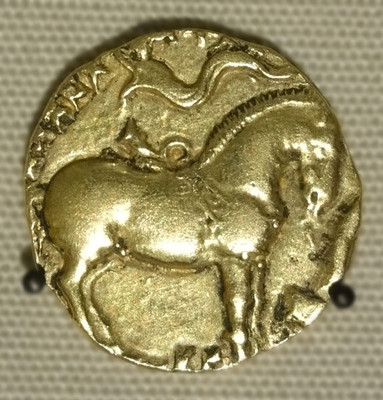I'm here in the temple at four in the afternoon-couldn't be here before, because the gods were asleep, and what I'm hearing now is the music played every day to waken them up.
我是在4点左右抵达这座神庙,现在的时段谢绝访客,音乐响起,唤醒众神。
They are woken up now, and so I'm allowed to go and engage with them. It's rather obvious I suppose, but to interact with a god in this intimate way, we need to be able to recognise them-but how are they to be identified?
众神已经醒来,因此我现在可以允许进行接触。我想,很明显,但是与神进行这样亲密的接触,我们需要进行辨认,但如何能够辨认呢?
Well, I've already found the great gods Shiva and Vishnu, because I'm familiar with them from the British Museum. Here's Shiva, with his wife Parvati and his trident, and here is Vishnu, sitting with his four arms, holding discus and lotus flower.And on a pillar nearby is a god who was particularly important for the Gupta kings-Shiva's son Kumara. All these Hindu gods began to assume the shapes we recognise today in the brand-new temples built by the Gupta kings.
湿婆与毗湿奴很容易辨认,前者我在大英博物馆已经再熟悉不过,与自己的妻子雪山神女在一起,后者则端坐着,四条手臂拿着铁饼与莲花。附近通常还有一个对笈多王朝十分重要的神,即湿婆的儿子鸠摩罗,现在又叫卡尔凯蒂耶。在北印度笈多国王修建的新神庙里,所有的印度神都开始以我们如今熟悉的形象呈现。
The Gupta Dynasty began a little after the year 300, and it rapidly expanded from its base in northern India, until it covered a good deal of the subcontinent. So that by 450, the Gupta Empire-along with Iran and the Eastern Roman Empire, Byzantium-was one of the world's three superpowers.
笈多王朝始于公元300年后不久,以北印度为中心迅速开始扩张,占领了印度次大陆的大部分领土。公元450年,王朝成为该地区的超级势力,与伊朗及东罗马帝国(拜占庭)比肩。
Not long after Constantine in Rome had established Christianity, the Gupta kings in North India set many of the enduring forms of Hinduism-creating the complex apparatus of faith, with temples and priests, and commissioning the images of the gods that we know now.
不久以后罗马的君士坦丁大帝承认基督教合法,其后不久,北印度的笈多王朝便制定出印度教许多流传至今的形式—复杂的宗教结构、庙宇、僧侣,以及我们今天能看到的众神形象。
Why does this happen at this point in history? As with Christianity and Buddhism, which around the same time portray both Christ and Buddha in human form, it seems to be to do with empire, wealth and the power of art.
为什么硬币上的形象是马而不是国王?这源自印度教诞生之前就已存在的一种古老的祭祀仪式,之前的印度国王一直奉行,笈多的国王也将其继承了下来。这似乎与帝国,财富和艺术有关。












